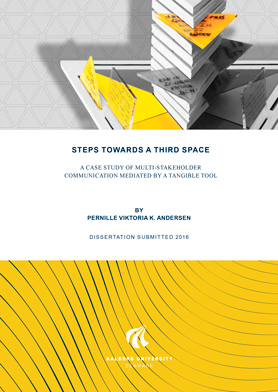Steps Towards a Third Space - A Case Study of Multi-Stakeholder Communication Mediated by a Tangible Tool
By Pernille Viktoria K. Andersen
Within the present PhD thesis, I explore and analyse the implications of multistakeholdercommunication in the early phases of practical, cross-disciplinaryresearch. Specifically, my research explores and develops ideas for howcommunication mediated by a tangible tool can support multiple parties to movetowards a common ground of mutual exploration of a problem space. This researchis based on theories of communication, and derives support from the discussionsinherent in Participatory Design and Design Anthropology in regards to stakeholderengagement.
The research is situated in a cross-disciplinary research project ‘UserTEC - UserPractices, Technologies and Residential Energy Consumption’ and takes the form ofa single case study. The primary data for in depth analysis in this research involveaudio and video data collected through two partner-meeting workshops withinUserTEC.
As part of my research a tangible and thought-provoking tool was developed andtested. I call the tool 3P. The design and evaluation of 3P is based on the idea, alsoexplored within Participatory Design, that for multiple stakeholders to arrive at acommon ground for joint action, all participants must leave their comfort zone andon equal footing try to act together in uncharted territory. An instance which inParticipatory Design is termed ‘third spacing’. My research shows that arriving at‘third space’ communication is complex; it takes time, effort, and skill. A problemanalysis of the challenges of multi-stakeholder communication in UserTEC as wellas attention towards theoretical studies of communication has lead me to suggest,that striving for dialogue is not a sufficient strategy in multi-stakeholder settings.Instead confrontation of antagonistic viewpoints must precede converging dialogue.
The design brief for 3P is based on problem analysis of the UserTECcommunication, as well as inspired by the notion of reengagement with criticalvoices (a concept belonging to Design Anthropology). This research has lead to thefollowing four requirements for the 3P tool to fulfil - requirements that have beenrefined throughout the research process. It must:
- Encourage reengagement with the current troubles, represented bysituated dilemmas into versus-narratives.
- Share differentiated professional positions (differences in interests,assumptions and perceptions), based on a common frame of reference.
- Explore the key agreements and disagreements of a subject, andprompt the collective exploration of alternatives (a collectivelyexpanded and elaborate understanding of a problem)
- Overcome communicative closure.
3P has been tested in a UserTEC partner workshop, in which video data has beengenerated. Data has been analysed bottom up, in accordance with situated interactionanalysis, originally proposed by Jordan & Henderson (1995), as well as throughvarious coding strategies, paying attention to what participants say, what they dowhile talking. By an analytical double take, I have selected passages where 3Pencourage participants to engage with opposites, and analyse these passages, as bothinstrumental to keep the group on track, and as springboards to a ‘third space,’where participants step out of their comfort zones and start listening to new ideasand see new possibilities.
My research demonstrates the complexity of what it takes to facilitate the oftenignoredfirst step of bringing people of different professions together, when in aproblem formulation situation. Empirical analysis has lead to the identification offour fundamental levels of participants’ communicative orientations, wheninteracting with 3P, that move from instrumental orientation to discursive expansion.These four orientations function as steps that are necessary to progress through - atleast for the participants of this study - in order to move towards a ‘third space’ ofmutual exploration. This research has lead to the development of a concept ofcommunication, which I call ‘versus-communication’. It is a form of dialecticalcommunication that arises when participants adopt and embrace (touch and refer to)dichotomous re-presentations of situated dilemmas through use of the 3Pcommunication tool. In general, this form of communication seems to lead to a‘third space’.
Within this research context, 3P has served as a probing instrument. Whether 3P hasa future in practical, multi-stakeholder communication within the constructionindustry or as part of the ‘green transition’ agenda is a matter of further testing anddevelopment - research I’m keen to pursue.

